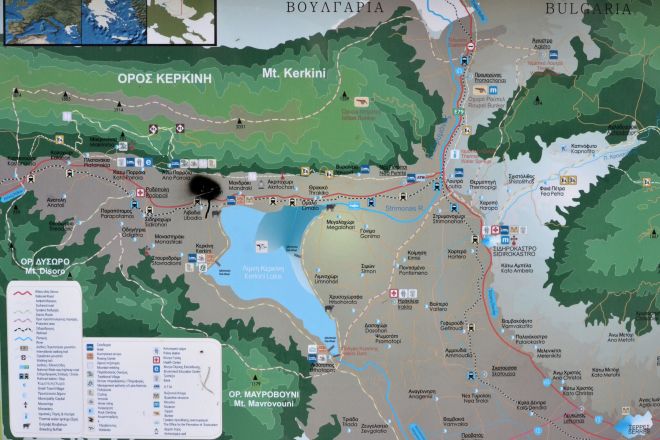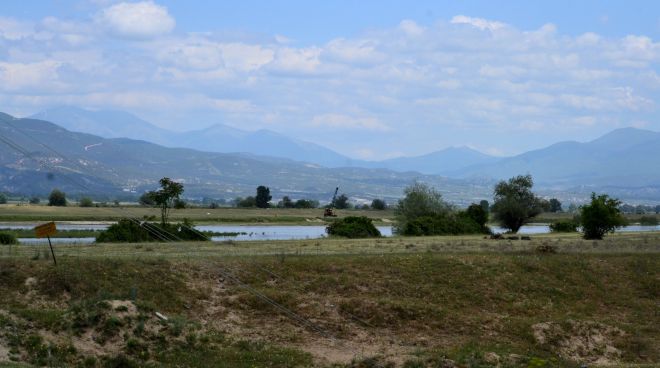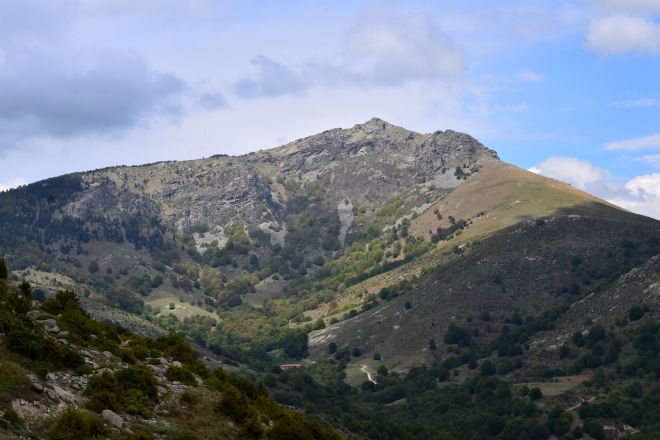 The huge, man-made reservoir of Lake Kerkini was created by flooding an area of former marshland lying between the Belles Mountains on the Greece / Bulgaria border in the north, and the Mavrovouni Mountains to the south-west. On three separate days during the Naturetrek tour I joined here our group visited a number of locations in the northern range that is split in two by the River Strimonas valley.
The huge, man-made reservoir of Lake Kerkini was created by flooding an area of former marshland lying between the Belles Mountains on the Greece / Bulgaria border in the north, and the Mavrovouni Mountains to the south-west. On three separate days during the Naturetrek tour I joined here our group visited a number of locations in the northern range that is split in two by the River Strimonas valley.

The Strimonas valley and river with mountains beyond
On Monday (8th) we drove up into the mountains to the east of this divide. Our first stop was another quarry location near a town Sidirokastro. This reminded me of many places visited in southern France and we encountered some of the same birds. Several each of Black-eared Wheatear and Blue Rock Thrush adorned the cliff tops while the air space was filled by Barn and Red-rumped Swallow and Crag Martin. But once again Rock Nuthatch that are said to breed at the site eluded us.
From there we drove eastward into the mountain range, stopping at a raptor viewpoint. There some of my colleagues scanned the distantly soaring birds, picking out Long-legged amongst the Buzzards. But as is well known at home I am not greatly motivated by specks in the sky, though a Griffon Vulture here must be quite a record for the area as well as a very big speck. This was also a Masked Shrike site and the resident pair tantalised us from bush top perches.
Unsurprisingly I became distracted by what was happening on the ground. This (below) is Chapman’s Blue, a butterfly I had pondered over before in the southern European field, but not ID’d conclusively until now. The underwing pattern in the right hand picture exactly matches the illustration in Collins. Lesser Spotted Fritillary, the trip’s most frequently seen butterfly was also flying here but not much else.
We now drove onward in search of warblers. I was impressed by our tour leader, Phil Thompson’s skill in listening for birds through the minibus window while driving. Eventually we stopped to observe a roadside Woodchat Shrike and he heard an Eastern Orphean Warbler that flew further along the road. We followed but could not relocate it, then stopped instead at a corner where we found a nesting pair of Eastern Subalpine Warbler. I have not searched for small, skulking birds such as these two warblers when birding alone in southern Europe because that is too much like hard work. Hence another reason for coming out with a group and expert leader this time, and didn’t my tour colleagues just love the skulkers and specks!
This was our outward turning point and on turning back both the Woodchat and another Masked Shrike were active again where the Orphean Warbler had been a short time earlier. We played a phone app recording to try to attract the last-named and it came out of cover and crossed the road towards us. This big chunky warbler then perched briefly and prominently in the bare top of a thorny shrub, giving everyone excellent views. On my scale of lifers this one is fairly huge as its western equivalent is one of those elite though dwindling stragglers of my south-west Europe wish list.
After lunch back at the watch point we returned to Sidirokastro where a rock face in the town centre is another reliable location for Rock Nuthatch that birding tours to the area all visit. There was even an ice cream parlour opposite the cliff in the past where birders could sit and watch, but that has now shut down. Indeed it was third time lucky for us as this large, pale Nuthatch bobbed and ducked on a ledge close to twin mud nests that he would sometimes fly onto; an easy observation in the end (lifer, pictured below).
We now continued east from the town along the Strimonas valley towards the Bulgarian border. In this area one wood that holds several Woodpecker species is another regular stop for visiting bird tours. The dense canopy here made me pessimistic about gaining Syrian, the one remaining pecker I still need after April’s Estonia trip. The white-barked Maples that we looked up into were an imposing sight though our tally was indeed one Great Spotted Woodpecker. But a superb find here was Sombre Tit, the trip’s eighth lifer and my 450th career bird, but more of that species in the next post.
The site had become flooded in places at our chosen entry point, so we went to look for alternative ways in. Stopping at the head of one track we came across what I am assured is the butterfly of the trip. Iolas Blue (pictured below, left) is a rarity much sought by collectors, having a patchy and highly localised distribution across south-eastern Europe. One of the largest Blues, its status is not helped by robbers stripping it’s food plant of the seed pods in which the larvae feed, in search of eggs.
Two more Masked Shrike (pictured above, right) were also active at this stopping place. Though at the edge of its breeding range in northern Greece, we did very well for this charming little Shrike through the week, indeed coming across eight separate individuals on this day (8th). We also disturbed a Middle Spotted Woodpecker that flew away calling loudly. I recognised that sound at once from my recent experience of the species in Estonia.
On Wednesday (10th) we penetrated the Belles Mountains further to the south-east above a town Serres. Access into this area is mostly by dirt roads but on one peak, Mount Vrondou (c1900m) there is a small scale ski centre and so a metalled road goes all the way up. The landscape and montane habitat here is Alpine rather than Mediterranean and within it we set out to explore a very different bird mix to that occurring at lower elevations. At the summit the stand-out birds were Common Crossbill and Tree Pipit, while much of the other bird life was of common species from home such as Robin, Chaffinch, Chiffchaff and Lesser Whitethroat.

The peak of Mount Vrondou
For the rest of the day we made our way back down the mountain, stopping at various locations. Our first walk was along a track into the mixed beech and pine forest that cloaks the slopes immediately below the summit. The main interest for me here was butterflies that will be dealt with in a separate post. These included two new (for me) regional butterfly species, Northern Wall Brown and Eastern Wood White.
Below the treeline we stopped for our picnic lunch on a grassy, rocky slope that we shared with three different lizard species. The haunting song of Woodlark revealed their own presence here, and Red-backed Shrike was seen again. Fortunately in this trip’s company I am able to put names to the reptiles. In this collage (below) are Erhard’s Wall Lizard, Balkan Wall Lizard and a male Common Green Lizard in its breeding colours.
This (below, left) is something I haven’t seen before: a Dung Beetle rolling dung on which their larvae feed in the nest. They apparently prefer to go in reverse so I’m not sure how they get the dung back home. Well I have to write about something other than birds in this journal from time to time! The right hand one for obvious reasons is a Rhinocerous Horn Beetle. There were a lot of Green-winged Orchid growing on these slopes so I have included a picture.
Lower down again we came upon one of the region’s key mountain birds Rufous-tailed Rock Thrush, only my second and another of those sightings that were not accepted in Cyprus. The male (pictured below) kept us amused as it moved around a slope below a bend in the road. This altitude specialist breeds only above 1500m in habitat such as this or higher Alpine meadows. The striking red, slate grey and dark blue colouration is offset by a white patch in the middle of the back that resembles a large dropping from on high. Another Red-backed Shrike and Cirl Bunting were also active at this last site on 10th.
In the early afternoon of our final day in Macedonia we took a walk through a scenic forest site to the west of the Strimonas divide, above a village Ano Poroia. Here my tour colleagues enjoyed themselves craning their necks in search of woodland birds. The week’s only Black Woodpecker was heard but very little actually revealed itself. For me the main interest was a second dragonfly lifer for the trip. I had been led to expect Eastern Spectre (pictured below) by the tour leader, but still mistook it at first for Blue-eyed Hawker for obvious reasons. Doh! – we were in quite the wrong habitat for the latter.
This small and sleek dragonfly is common in most of its range from the Balkans and northern Greece east through the Caucasus, into northern Israel and as far as Afghanistan. It occurs strictly around fast-flowing and shaded streams, and is crepuscular in habit with a preference for suspended perches in semi-shade, as in the picture. Mature males are brown-black with crisp blue markings, with “inverted 7” antehumeral stripes on the thorax. Another diagnostic is the short dark pterostigma (wing dots).
The Belles Mountains had produced four additions to my bird life list, four previously unseen (for me) butterflies and one new dragonfly. More birds – Syrian Woodpecker, Eastern Bonelli’s Warbler, Collared and Semi-collared Flycatcher (all potential lifers), even Nutcracker and Western Capercaillie – may also be found here but these could require a lot of time and effort to locate. Our group’s approach was not one of intensive dawn to dusk birding since everyone had other wildlife interests too, as this post reflects. Despite the motivation for growing my avian life list, just being in beautiful wild places and enjoying the habitat often becomes more important during days in the field abroad; and so it proved again in Greek Macedonia.























